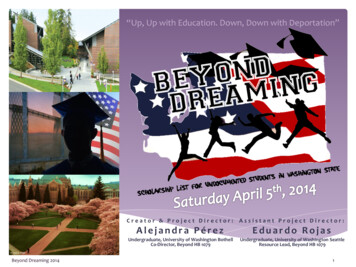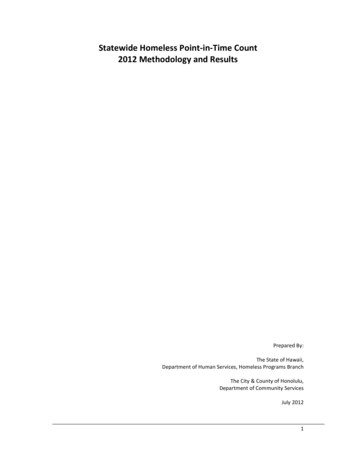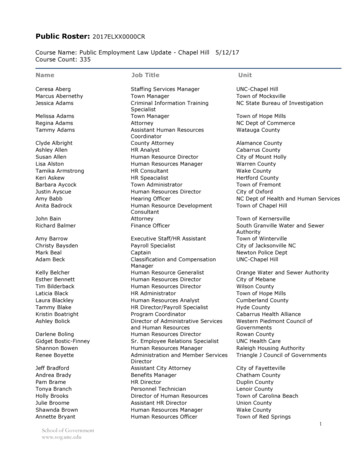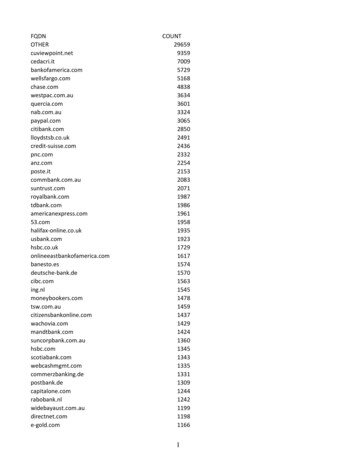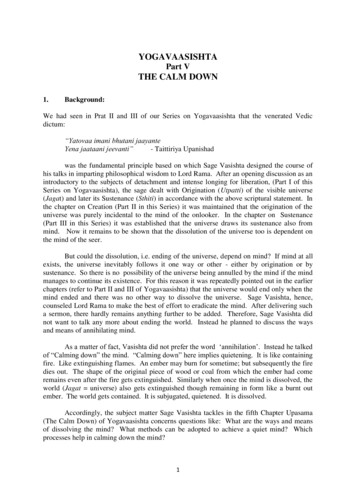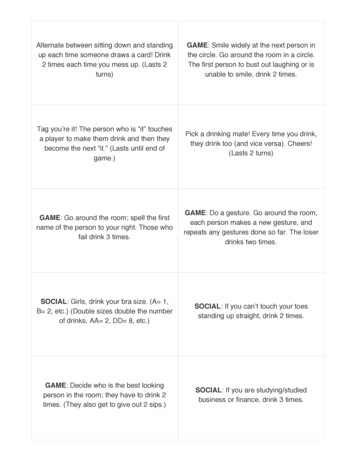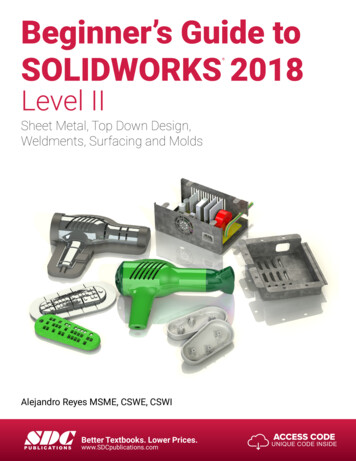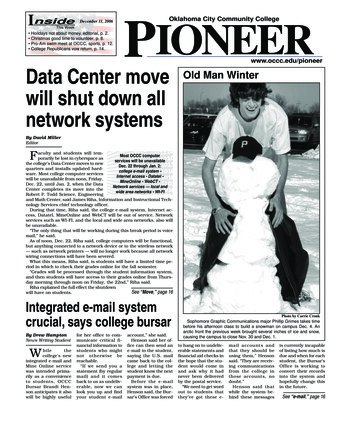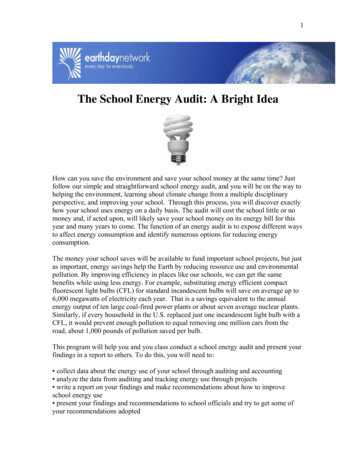
Transcription
1The School Energy Audit: A Bright IdeaHow can you save the environment and save your school money at the same time? Justfollow our simple and straightforward school energy audit, and you will be on the way tohelping the environment, learning about climate change from a multiple disciplinaryperspective, and improving your school. Through this process, you will discover exactlyhow your school uses energy on a daily basis. The audit will cost the school little or nomoney and, if acted upon, will likely save your school money on its energy bill for thisyear and many years to come. The function of an energy audit is to expose different waysto affect energy consumption and identify numerous options for reducing energyconsumption.The money your school saves will be available to fund important school projects, but justas important, energy savings help the Earth by reducing resource use and environmentalpollution. By improving efficiency in places like our schools, we can get the samebenefits while using less energy. For example, substituting energy efficient compactfluorescent light bulbs (CFL) for standard incandescent bulbs will save on average up to6,000 megawatts of electricity each year. That is a savings equivalent to the annualenergy output of ten large coal-fired power plants or about seven average nuclear plants.Similarly, if every household in the U.S. replaced just one incandescent light bulb with aCFL, it would prevent enough pollution to equal removing one million cars from theroad, about 1,000 pounds of pollution saved per bulb.This program will help you and you class conduct a school energy audit and present yourfindings in a report to others. To do this, you will need to: collect data about the energy use of your school through auditing and accounting analyze the data from auditing and tracking energy use through projects write a report on your findings and make recommendations about how to improveschool energy use present your findings and recommendations to school officials and try to get some ofyour recommendations adopted
2Beginning Exercise:As a class, list some factors that influence how your school uses energy.1.2.3.4.Accounting – Understanding Your BillsNext, spend some time going over your school’s bills to see how it is billed for theresources it uses.ProjectObtain data on the cost and use of energy, water, and garbage services at your school.Equipment and Information needed:1. School Resource Use Table (below)2. School utility bills from the most recent year showing usage and cost3. Information to understand how usage is converted to costSchool Resource Use TableMonthJANFEB.MARAPRMAYJUNEElectricityKWHCost Natural GasThermsCost Fuel OilGallonsCost WaterGal
3JULYAUG.SEPT.OCT.NOV.DECTotalTotalCostLighting AuditGoing renewable through wind, solar, geothermal, etc is a self-evident method forsaving the planet while reducing your energy output. If you can do it yourself or find anenergy supplier that provides one of the aforementioned resources, by all means pursuesuch an option. However, not every school has the access or capacity to go renewableright now, much less implement even a solar water heater. Therefore, the reformation ofyour school’s lighting system is one method that any school can do to drastically andeasily conserve energy. Lighting your school takes energy and money, but so does themaintenance of the lighting system. As the chart below shows, incandescent bulbs haveto be replaced more often than fluorescent ones, leading to longer maintenance hoursspent on lighting.Performance Characteristics of Various Light SourcesLamp TypeStandard IncandescentTungsten-HalogenCompact Fluorescent (5-26 watts)Compact Fluorescent (27-40 watts)Efficacy (Lumens/Watt)5-2015-2520-5550-80Average Life (Hours)750-10002000-400010,00015,000-20,000
4Problem:You are about to buy a light bulb for 5.50 that has a rated life of 850 hours. You thennotice that you can buy a bulb that produces the same light for 18,000 hours, but costs 62.00. Energy use is the same for each bulb. Which bulb is the better bargain?The 5.50 bulb The 62.00 bulb*Hint: you will have to buy about 21 bulbs with a life of 850 hours to get 18,000 hours ofservice (21 X 850 17,850 hours). Those 21 bulbs will cost you approximately 115.50!ProjectDo a Lighting Inventory for your school and complete the Room Lighting Checklistbelow.Equipment needed:1. Tape Measure2. Light meter3. School Room Locator4. Lighting Survey Form (below)Procedure:1. Determine lamp type for room2. Take Light Level Readings (Foot-candles)3. Record number of light bulbs and their wattage4. Record how lights are controlled5. Record number of tubes per fixture (Luminare)Write a report analyzing how well your school performs relative to existing lightingstandards in your area.Room Lighting ChecklistRoomRoomNumber s(3)Comments(4)
51. Room use: List primary activity such as science, office, art, etc.2. Bulb Count/ Watts: Identify the type and number of bulbs and their wattage. Ifapplicable, include ballast type and wattage.3. Foot Candles: The reading obtained from the light meter at a set location.4. Comments: Does the room have windows and/or skylights? Are the reflectors dirty? Isthe ceiling reflective?Water AuditThere are many ways you can help your school save money on water usage, such aschecking for leaks in the system, reducing water usage (especially hot water), andimproving the efficiency of water delivery.Problem: Measuring FlowratesUse a one gallon container in the school gym showers or a sink to determine the flow ratein gallons per minute. To measure the flow rate, turn on both the hot and cold water andadjust the temperature of the water and the flow to the temperature at which you wouldnormally shower or wash your hands. Note the time on a watch (with a second hand) andfill the one gallon bucket, recording how much time it takes to fill in seconds.1 gallon shower/sink water seconds. Divide this numberby one and multiply the result by 60 to get gallons per minute GPM.Now turn off the cold water and find out how long it takes to fill the one gallon containerwith hot water.1 gallon hot water seconds. Again divide thisnumber by one and multiply the result by 60 to getgallons hot water per minute GPM.
6*Low-flow showerheads are available that provide hot showers and use only 2.5 GPM orless. If your flow rate is in excess of 2.5 GPM, energy can be saved by changing theshower heads. The same is true for automatic sink sensors, which appropriate andconserve sink water and reduce cost over a greater period of time.ProjectFind the following information about your school:1. Amount of hot water (gallons) used per month (record on table below)2. Amount of electricity (KWH) or natural gas (Therms) used per monthto heat water3. GPM (flow rate of school showers/sinks in gallons per minute)4. Volume of water used in cubic feet per minute5. Energy cost per cubic foot* and per gallon6. Number of calories* of energy needed to heat water per gallon and perliter (Note: 2.78 Liters 1 gallon)*One cubic foot equals 7.69 gal*One calorie equals the amount of energy necessary to heat 1 gram of water 1degree Centigrade. 1 gram of water is equal to a milliliter.Calculate the amount of energy used to heat water at your school:Equipment needed:1. Thermometer2. One gallon container3. One liter flaskInformation you will need:Total amount of hot water used per month (cubic feet)Type of energy used to heat water (fuel, natural gas, electricity)1. Measure the temperature of both cold and hot tap water using athermometer that measures in Celsius, then find the difference between thetwo.2. How many calories does it take to heat a liter of water at your school?3. How many calories does it take to heat a gallon of water?4. How many calories does it take to heat a cubic foot of water? (There are7.69 gallons per cubic foot)
75. How many calories does it take to heat the water your school uses eachmonth? (About one third of the total water used is heated).Convert Total Calories (#4) to:6. Kilowatt Hours7. Calculate the cost of meeting the hot water needs at your school permonth using a gas water heater and an electric water heater.8. Record your conclusions regarding water heater efficiency, systemefficiency, and rates.True or False:If incoming water is preheated by running through solar panels, it will take less energy toheat the water and will save money. T F Why or why not?(Answer is True, since over a given period of time, heating is on-site (cheaper) and theonly related costs are for maintenance, with sell back options being a perk.)Write a report presenting your findings relating to water use in the school.School Hot Water BERNOVEMBERDECEMBERTotalsCubic Feet (CF)Gallons (Gal)Liters (L)Energy Dollars ( )
8Food Services AuditIn the KitchenIn some areas you will pay more for the electricity used by some refrigerator modelsduring their lifetimes than you originally paid for the refrigerator. Alternatively, moreefficient models (energy star appliances) are available and could be more cost effectivethan the equipment at your school.Pilot lights use as much as 30% of all the gas a range uses, so turn them off over breaksor long hours of non-operation.Problem:In an experiment, cooking the same recipes in the same kitchen with the same utensils,some cooks can use half as much energy as others. How?Answer:a. Using pots about the same diameter as the burnerb. Using lids on their potsc. Using a pressure cooker instead of a regular potd. Turning the burner off a few minutes before the dish is donee. Deciding what is needed before opening the refrigerator doorf. Taking from the refrigerator everything needed for a meal at onceg. Running only full loads in the dishwasherProjectInspect the food service area of your school and evaluate the conditions.Equipment Needed:1. ThermometerComplete the following cooking and dishwashing checklists.CookingYesNoCommercial Food Service Energy Conservation ChecklistSecond fry unit, broiler, oven, etc. used only for peak business hours.Oven preheats at desired temperature; not at a higher temperature.Smaller energy efficient ovens used whenever possible.Ovens loads and unloads quickly to avoid unnecessary heat loss. Everysecond an oven is open it loses about one percent of its heat.
9Cooking and heating units not in use are turned off.Meat cooked slowly at low temperatures. Cooking on roast for five hours at250o F saves 25-50 percent of the energy used in cooking for three hours at350o F.Baking and roasting scheduled so that oven capacity can be fully utilized.Ovens are not opened during operation.Food cooked on small part of grill heating only portion being cooked on.Fryers cleaned and oil filtered at least once a day.Food warmers and hot plates turned on only as needed.Dishwasher - Water HeatingYesNoDishwasher and Water HeatingoFonclosing,at 140o F two hours before opening.Water at 75Drain water heater every six months.Use hot water only when necessary.Dishwashers run only when there is a full load.Hot water heater coils free from lime accumulations.Leaking faucets?Water pressure regulators on hot water lines to reduce wasted hot water.Hot water lines insulated?General-use hot water temperature at 140o F. Taps at 110o F.Cleaning done during daylight hours?Mop from bucket to conserve hot water?Additional note to the kitchen audit: creating a nature center, greenhouse, or schoolgarden on-site can significantly reduce energy and food costs for your school. It alsoprovides a hands-on learning experience for many disciplines, and provides a healthieralternative to junk food, soda, and other unhealthy options common to schools. In fact, aseparate project could consist in finding local sources for your food service, used as anaddendum to this audit to manifest greater monetary savings and benefit to theenvironment.RecyclingAnother important way to save energy at your school is through recycling. This can bedone all over the school. For example, you can save by recycling paper milk cartons fromthe lunch room or printer cartridges in the copy room. By recycling paper, milk cartonsand other materials, schools are able to reduce the amount of waste they produce. Thiscan garner significant savings as well as benefit the environment. Become familiar with
10your school’s solid waste contract and resources in your community relating to solidwaste. In many communities there are individuals and organizations that will help youset up a program that is appropriate for your school and geographic area.Using materials over again can save energy, so get creative. Half of a two liter bottle canbecome a pot for growing plants, or glass bottles can become a piece of art. To illustrate,it takes about 20 times more energy to get aluminum from ore (bauxite) than from usedcans, so it makes a lot of sense to reduce, reuse, and recycle.Additionally, buying items and selecting options that will last a long time, can be repairedif they break, are made from recycled materials, can be recycled, and have minimalpackaging are all excellent ways of saving energy.The Project ReportOnce you have completed the work in this program you are ready to assemble your dataand make formal energy recommendations. Make an appointment with the appropriateindividuals responsible for operation and maintenance of the building to present yourenergy audit findings. Try to identify the major sources of energy use and evaluate howmuch it will cost to implement your recommendations. Further, estimate payback bycomparing the cost of your recommendation divided by the energy saved each year. Forexample, if it costs 18,000 to do a lighting retrofit that saves 6,000/year, the payback is 18,
Yes No Commercial Food Service Energy Conservation Checklist Second fry unit, broiler, oven, etc. used only for peak business hours. Oven preheats at desired temperature; not at a higher temperature. Smaller energy efficient ovens used whenever possible. Ovens loads and unloads quickly to avoid unnecessary heat loss. Every
